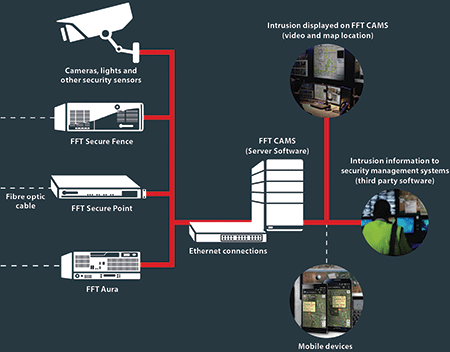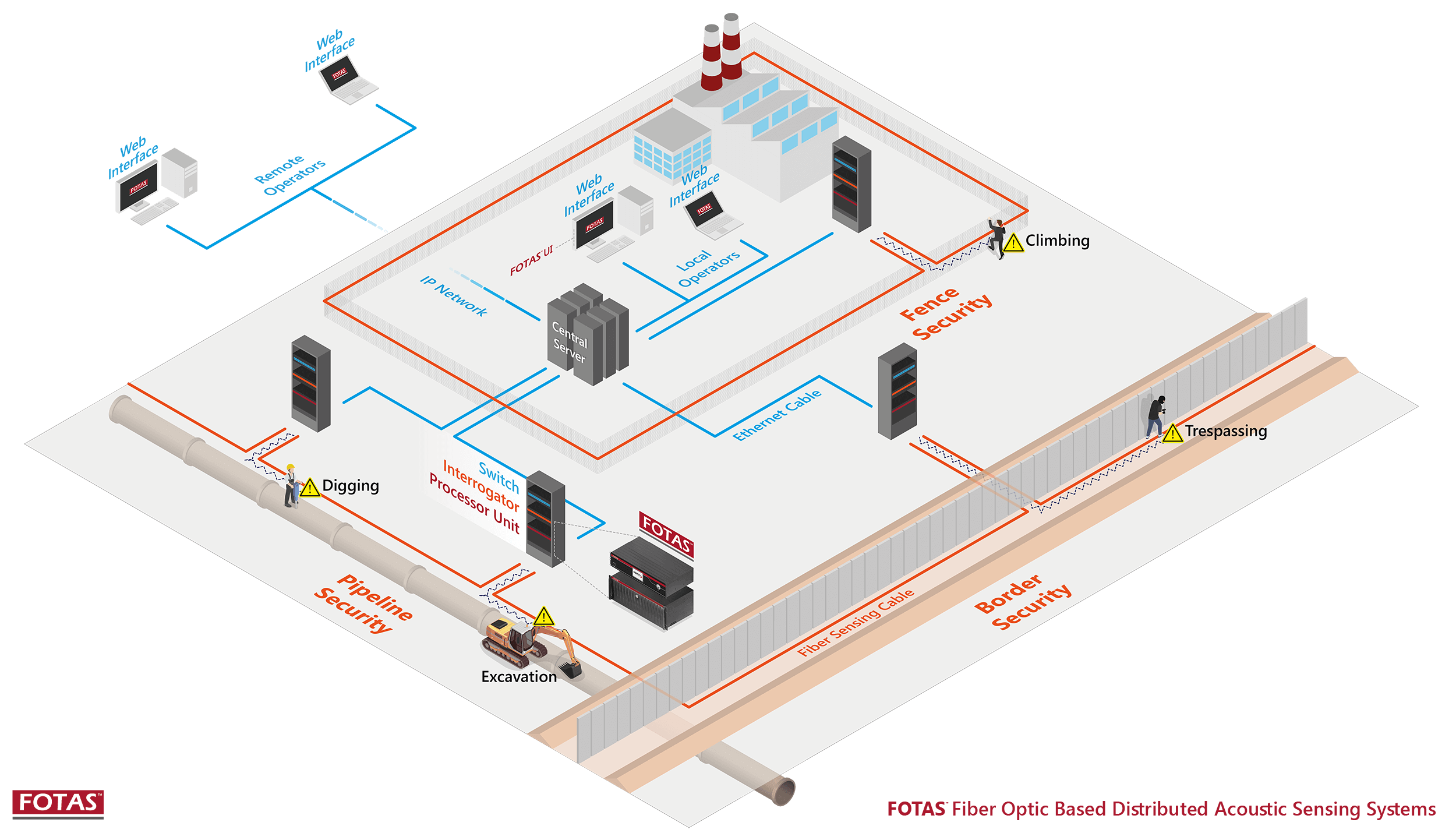Why Fiber Optic Protection Systems Are the Future of Defense
The shift to fiber optic safety and security systems marks a considerable improvement in the realm of protection, driven by their extraordinary data transmission abilities and resilience to external interferences. These systems not only facilitate faster and extra trustworthy communication but additionally provide an affordable service with decreased maintenance requirements. As the landscape of protection develops together with arising innovations such as AI and IoT, the possibility for optical fiber to boost and redefine security infrastructures ends up being progressively apparent. Nonetheless, the ramifications of these innovations elevate vital questions about the future of safety steps and their performance in an ever-changing environment.
Benefits of Fiber Optic Solutions
Among the main benefits of fiber optic systems is their remarkable bandwidth ability, which helps with the transmission of huge volumes of information over fars away without significant loss. This characteristic is especially valuable for protection applications that call for the continuous tracking and transfer of high-def video clip feeds, sensing unit data, and other crucial information. Optical fiber can fit the growing demands of modern-day protection systems, making sure that information continues to be undamaged and trusted.
In addition, fiber optic cables are less vulnerable to electro-magnetic disturbance, which can be a substantial issue in settings with various digital tools. This resistance boosts the honesty of the information being sent, thus lessening the danger of data violations or system failings. Fiber optic systems are naturally much more safe than standard copper cable televisions, as touching into a fiber optic line without discovery is exceptionally challenging.
The sturdiness of fiber optic cables additionally adds to their appeal. They are immune to ecological aspects such as wetness and temperature changes, minimizing maintenance expenses and boosting system longevity. Overall, these benefits position fiber optic systems as a durable and reliable choice for contemporary safety facilities, ensuring trusted and safe data transmission.
Improved Information Transmission Speed

The capability to transmit huge quantities of information rapidly facilitates the seamless integration of high-definition video feeds and advanced analytics. Protection systems can currently refine and examine info in real-time, enhancing action times and situational understanding. Furthermore, fiber optic links sustain longer transmission distances without deterioration of signal quality, making them excellent for extensive safety and security networks.
The boosted rate of fiber optic systems not only improves the effectiveness of safety procedures yet additionally lowers latency. This is especially essential in crucial circumstances where timely decision-making can stop protection violations or alleviate prospective dangers. As companies proceed to focus on security and efficiency, the need for fast and trustworthy data transmission will definitely strengthen fiber optic systems as a cornerstone of contemporary protection facilities.
Resistance to Disturbance
Fiber optic protection systems continually demonstrate exceptional resistance to electromagnetic disturbance, a critical benefit in settings prone to electronic noise. Unlike typical copper cords, which can be negatively affected by magnetic fields, superhigh frequency interference, and other forms of electric disruption, fiber optic cable televisions utilize light to send information. This inherent residential property ensures that the signals continue to be clear and unchanged, despite bordering digital task.
Using glass or plastic fibers in fiber optic technology produces a barrier against interference, enabling reputable data transmission also in difficult situations such as commercial facilities, city areas with high electronic web traffic, or places near radio towers. This particular considerably decreases the probability of signal destruction or loss, making fiber optic systems specifically ideal for safety applications where honesty and precision of data are paramount.
Additionally, this resistance to disturbance boosts the total efficiency and integrity of protection systems, ensuring that tracking and alert systems operate flawlessly. In a globe where safety and security is progressively endangered by sophisticated technologies, the durability of fiber optic systems stands out as a pivotal attribute, enhancing their status as an important element of contemporary protection infrastructure.
Cost-Effectiveness Gradually
Substantial expense savings can be achieved with time with the execution of fiber optic protection systems. While the first financial investment important source may seem higher compared to typical copper-based systems, the long-term financial advantages come to be apparent with decreased functional and upkeep prices (fiber security). Fiber optic cords are inherently a lot more long lasting and less susceptible to environmental factors, which translates to reduce substitute and fixing expenditures over their life-span
Moreover, fiber optic systems require much less power to operate, which additionally reduces power expenses. Enhanced information transmission abilities permit less repeaters and amplifiers, lessening devices investment and enhancing installment processes. The scalability of these systems likewise adds to cost-effectiveness, as companies can expand their protection framework without incurring significant added costs.
An additional factor to think about is the enhanced efficiency in surveillance and reaction abilities that optical fiber give. Enhanced real-time data transmission can lead to quicker event response times, possibly mitigating losses and obligations connected with security violations. Altogether, the long-lasting benefits of fiber optic safety systems not only warrant the first expense but additionally place them as an economically prudent choice for organizations seeking robust protection services.

Future Advancements in Safety
Advancing modern technologies are set to change protection systems, integrating expert system (AI) and machine understanding to boost threat discovery and reaction capacities. These developments will allow safety systems to evaluate vast amounts of information in real-time, identifying patterns and abnormalities that show prospective hazards. This proactive strategy will allow faster decision-making and much more efficient event actions.
Additionally, the unification of the Web of Things (IoT) is leading the way for interconnected protection devices, providing comprehensive security and tracking. Smart sensors can relay info concerning environmental changes, while automated notifies can blog notify safety and security personnel quickly of questionable tasks.
Furthermore, the development of biometric innovations will certainly even more bolster safety and security systems. Facial acknowledgment, finger i loved this print scanning, and retina recognition are becoming much more innovative, offering layers of authentication that are challenging to bypass.
Conclusion
To conclude, fiber optic safety and security systems stand for a significant development in protection technology, offering exceptional data transmission rate, resistance to electromagnetic interference, and long-lasting cost-effectiveness. As the demand for advanced safety and security remedies continues to expand, the integration of optical fiber with emerging innovations such as AI, IoT, and biometrics will certainly better enhance protection frameworks (fiber security). The mix of these technologies will guarantee an extra secure and receptive atmosphere, strengthening fiber optics as a keystone of future safety and security systems